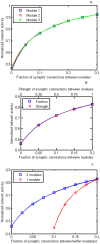Fiber pathway pathology, synapse loss and decline of cortical function in schizophrenia
- PMID: 23593232
- PMCID: PMC3620229
- DOI: 10.1371/journal.pone.0060518
Fiber pathway pathology, synapse loss and decline of cortical function in schizophrenia
Abstract
A quantitative cortical model is developed, based on both computational and simulation approaches, which relates measured changes in cortical activity of gray matter with changes in the integrity of longitudinal fiber pathways. The model consists of modules of up to 5,000 neurons each, 80% excitatory and 20% inhibitory, with these having different degrees of synaptic connectiveness both within a module as well as between modules. It is shown that if the inter-modular synaptic connections are reduced to zero while maintaining the intra-modular synaptic connections constant, then activity in the modules is reduced by about 50%. This agrees with experimental observations in which cortical electrical activity in a region of interest, measured using the rate of oxidative glucose metabolism (CMRglc(ox)), is reduced by about 50% when the cortical region is isolated, either by surgical means or by transient cold block. There is also a 50% decrease in measured cortical activity following inactivation of the nucleus of Meynert and the intra-laminar nuclei of the thalamus, which arise either following appropriate lesions or in sleep. This occurs in the model if the inter-modular synaptic connections require input from these nuclei in order to function. In schizophrenia there is a 24% decrease in functional anisotropy of longitudinal fasciculi accompanied by a 7% decrease in cortical activity (CMRglc(ox)).The cortical model predicts this, namely for a 24% decrease in the functioning of the inter-modular connections, either through the complete loss of 24% of axons subserving the connections or due to such a decrease in the efficacy of all the inter-modular connections, there will be about a 7% decrease in the activity of the modules. This work suggests that deterioration of longitudinal fasciculi in schizophrenia explains the loss of activity in the gray matter.
Conflict of interest statement
Figures




Similar articles
-
Cortical network models of impulse firing in the resting and active states predict cortical energetics.Proc Natl Acad Sci U S A. 2015 Mar 31;112(13):4134-9. doi: 10.1073/pnas.1411513112. Epub 2015 Mar 16. Proc Natl Acad Sci U S A. 2015. PMID: 25775588 Free PMC article.
-
Synapse-specific contributions in the cortical pathology of schizophrenia.Neurobiol Dis. 2013 May;53:26-35. doi: 10.1016/j.nbd.2013.01.009. Epub 2013 Jan 18. Neurobiol Dis. 2013. PMID: 23336981 Free PMC article. Review.
-
Alterations of cortical GABA neurons and network oscillations in schizophrenia.Curr Psychiatry Rep. 2010 Aug;12(4):335-44. doi: 10.1007/s11920-010-0124-8. Curr Psychiatry Rep. 2010. PMID: 20556669 Free PMC article. Review.
-
GABA neurons and the mechanisms of network oscillations: implications for understanding cortical dysfunction in schizophrenia.Schizophr Bull. 2008 Sep;34(5):944-61. doi: 10.1093/schbul/sbn070. Epub 2008 Jun 26. Schizophr Bull. 2008. PMID: 18586694 Free PMC article. Review.
-
Dopamine-Related Disruption of Functional Topography of Striatal Connections in Unmedicated Patients With Schizophrenia.JAMA Psychiatry. 2016 Aug 1;73(8):862-70. doi: 10.1001/jamapsychiatry.2016.0178. JAMA Psychiatry. 2016. PMID: 27145361 Free PMC article.
Cited by
-
Development of a computerized adaptive screening tool for overall psychopathology ("p").J Psychiatr Res. 2019 Sep;116:26-33. doi: 10.1016/j.jpsychires.2019.05.028. Epub 2019 Jun 1. J Psychiatr Res. 2019. PMID: 31176109 Free PMC article.
-
Neuregulin 1 Deficiency Modulates Adolescent Stress-Induced Dendritic Spine Loss in a Brain Region-Specific Manner and Increases Complement 4 Expression in the Hippocampus.Schizophr Bull. 2019 Mar 7;45(2):339-349. doi: 10.1093/schbul/sby029. Schizophr Bull. 2019. PMID: 29566220 Free PMC article.
-
Cortical Network Models of Firing Rates in the Resting and Active States Predict BOLD Responses.PLoS One. 2015 Dec 14;10(12):e0144796. doi: 10.1371/journal.pone.0144796. eCollection 2015. PLoS One. 2015. PMID: 26659399 Free PMC article.
-
Cortical network models of impulse firing in the resting and active states predict cortical energetics.Proc Natl Acad Sci U S A. 2015 Mar 31;112(13):4134-9. doi: 10.1073/pnas.1411513112. Epub 2015 Mar 16. Proc Natl Acad Sci U S A. 2015. PMID: 25775588 Free PMC article.
-
Deciphering microbiome and neuroactive immune gene interactions in schizophrenia.Neurobiol Dis. 2020 Feb;135:104331. doi: 10.1016/j.nbd.2018.11.016. Epub 2018 Nov 22. Neurobiol Dis. 2020. PMID: 30471416 Free PMC article. Review.
References
-
- Goldman-Rakic PS (1994) Working memory dysfunction in schizophrenia. J Neuropsychiatry Clin Neurosci 6: 348–357. - PubMed
-
- Silver H, Feldman P, Bilker W, Gur RC (2003) Working memory deficit as a core neuropsychological dysfunction in schizophrenia. Am J Psychiatry 160: 1809–1816. - PubMed
-
- Petrides M, Pandya DN (2002) Comparative cytoarchitectonic analysis of the human and the macaque ventrolateral prefrontal cortex and corticocortical connection patterns in the monkey. Eur J Neurosci 16: 291–310. - PubMed
-
- Schmahmann JD, Pandya DN, Wang R, Dai G, D’Arceuil HE, et al. (2007) Association fibre pathways of the brain: parallel observations from diffusion spectrum imaging and autoradiography. Brain 130: 630–653. - PubMed
Publication types
MeSH terms
Substances
LinkOut - more resources
Full Text Sources
Other Literature Sources
Medical

